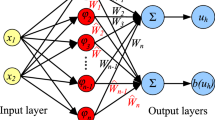Abstract
In this paper, numerical treatment is presented for the solution of boundary value problems of one-dimensional Bratu-type equations using artificial neural networks. Three types of transfer functions including Log-sigmoid, radial basis, and tan-sigmoid are used in the neural networks’ modeling. The optimum weights for all the three networks are searched with the interior point method. Various test cases of Bratu-type equations have been simulated using the developed models. The accuracy, convergence, and effectiveness of the methods are substantiated by a large number of simulation data for each model by taking enough independent runs.







Similar content being viewed by others
References
Jacobsen J, Schmitt K (2002) The Liouville–Bratu–Gelfand problem for radial operators. J Differ Equ 184:283–298
Buckmire R (2003) On exact and numerical solutions of the one-dimensional planar Bratu problem. Mathematics Department, Occidental College, Los Angeles, CA 90041-3338, USA. http://faculty.oxy.edu/ron/research/bratu/bratu.pdf
Frank-Kamenetski DA (1955) Diffusion and heat exchange in chemical kinetics. Princeton University Press, Princeton
Gelfand IM (1963) Some problems in the theory of quasi-linear equations. Trans Am Math Soc Ser 2:295–381
Wan YQ, Guo Q, Pan N (2004) Thermo-electro-hydrodynamic model for electrospinning process. Int J Nonlinear Sci Numer Simul 5(1):5–8
Buckmire R (2004) Application of a Mickens finite-difference scheme to the cylindrical Bratu–Gelfand problem. Numer Methods Partial Diff Equ 20(3):327–337
de Mounim AS, Dormale BM (2006) From the fitting techniques to accurate schemes for the Liouville–Bratu–Gelfand problem. Numer Methods Partial Diff Equ 22(4):761–775
Syam MI, Hamdan A (2006) An efficient method for solving Bratu equations. Appl Math Comput 176:704–713
Caglar H, Caglar N, Özer M, Valaristos A, Anagnostopoulos AN (2010) B-spline method for solving Bratu’s problem. Int J Comput Math 87(8):1885–1891
Deeba E, Khuri SA, Xie S (2000) An algorithm for solving boundary value problems. J Comput Phys 159:125–138
Wazwaz AM (2005) Adomian decomposition method for a reliable treatment of the Bratu-type equations. Appl Math Comput 166:652–663
Boyd JP Chebyshev polynomial expansions for simultaneous approximation of two branches of a function with application to the one-dimensional Bratu equation. Appl Math Comput 142:189–200
Abbasbandy S, Shivanian E (2010) Prediction of multiplicity of solutions of nonlinear boundary value problems: novel application of homotopy analysis method. Commun Nonlinear Sci Numer Simulat 15:3830–3846
Feng X, He Y, Meng J (2008) Application of homotopy perturbation method to the Bratu-type equations. Topol Methods Nonlinear Anal 31(2):243–252
Wang MC, Zhao XS, Liu X (2008) Analytic solutions of a class of nonlinearly dynamic systems. J Phys Conf Ser 96:1–7
Hassan IHAH, Erturk VS (2007) Applying differential transformation method to the one-dimensional planar Bratu problem. Int J Contemp Math Sci 2:1493–1504
Khuri SA (2004) A new approach to Bratu’s problem. Appl Math Comput 147:131–136
Aregbesola YAS (2003) Numerical solution of Bratu problem using the method of weighted residual. Electron J South Afr Math Sci 3(1):1–7
He JH (2006) Some asymptotic methods for strongly nonlinear equations. Int J Modern Phys B 20(10):1141–1199
He JH (2008) Variational approach to the Bratu’s problem. J Phys Conf Ser 96:012087
Jalilian R (2010) Non-polynomial spline method for solving Bratu’s problem. Comput Phys Commun 181:1868–1872
Boyd JP (2011) One-point pseudospectral collocation for the one-dimensional Bratu equation. Appl Math Comput 217:5553–5565
Abbasbandy S, Hashemi MS, Liu C-S (2011) The Lie-group shooting method for solving the Bratu equation. Commun Nonlinear Sci Numer Simul 16:4238–4249
Aarts LP, Veer PVD (2001) Neural network method for solving the partial differential equations. Neural Process Lett 14:261–271
Rarisi DR et al (2003) Solving differential equations with unsupervised neural networks. J Chem Eng Process 42:715–721
Shirvany Y, Hayati M, Moradian R (2009) Multilayer perceptron neural networks with novel unsupervised training method for numerical solution of the partial differential equations. Appl Soft Comput 9(1):20–29
Raja MAZ, Khan JA, Qureshi IM (2010) A new Stochastic approach for solution of Riccati differential equation of fractional order. Ann Math Artif Intell 60(3–4):229–250. doi:10.1007/s10472-010-9222-x
Raja MAZ, Khan JA, Qureshi IM (2011) Solution of fractional order system of Bagley-Torvik equation using Evolutionary computational intelligence. Math Probl Eng 675975:1–18
Khan JA, Raja MAZ, Qureshi IM (2011) Hybrid evolutionary computational approach: application to van der Pol oscillator. Int J Phys Sci 6(31):7247–7261
Raja MAZ, Ahmad SI, Samar R (2012) Neural network optimized with evolutionary computing technique for solving the 2-dimensional Bratu problem. Neural Comput Appl. doi:10.1007/s00521-012-1170-4
Raja MAZ, Khan JA, Ahmad SI, Qureshi IM (2013) Numerical treatment of Painleve equation I using neural networks and stochastic solvers. Springer, book series, studies in computational intelligence, 442, innovations in intelligent machines-3, chapter 7, pp 103–117
Khan JA, Raja MAZ, Qureshi IM (2011) Numerical treatment of nonlinear Emden-Fowler equation using stochastic technique. Ann Math Artif Intell 63(2):185–207. doi:10.1007/s10472-011-9272-8
Khan JA, Raja MAZ, Qureshi IM (2011) Stochastic computational approach for complex non-linear ordinary differential equations. Chin Phys Lett 28(2):020206. doi:10.1088/0256-307X/28/2/020206
Khan JA, Raja MAZ, Qureshi IM (2011) Novel approach for van der Pol oscillator on the continuous time domain. Chin Phys Lett 28(11):110205
Karmarkar N (1984) A new polynomial time algorithm for linear programming. Combinatorica 4:373–395
Wright SJ (1997) Primal-dual interior-point methods. SIAM, Philadelphia. ISBN 0-89871-382-X
Wright MH (2005) The interior-point revolution in optimization: history, recent developments, and lasting consequences. Bull Am Math Soc 42:39–56
Yana W, Wenb L, Lic W, Chunga CY, Wong KP (2011) Decomposition–coordination interior point method and its application to multi-area optimal reactive power flow. Int J Electr Power Energy Syst 33(1):55–60
Duvvuru N, Swarup KS (2011) A hybrid interior point assisted differential evolution algorithm for economic dispatch. IEEE Trans Power Syst 26(2):541–549
Author information
Authors and Affiliations
Corresponding author
Rights and permissions
About this article
Cite this article
Raja, M.A.Z., Ahmad, SuI. Numerical treatment for solving one-dimensional Bratu problem using neural networks. Neural Comput & Applic 24, 549–561 (2014). https://doi.org/10.1007/s00521-012-1261-2
Received:
Accepted:
Published:
Issue Date:
DOI: https://doi.org/10.1007/s00521-012-1261-2




